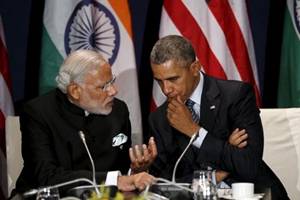After an interaction with world leaders and investors, Prime Minister Narendra Modi’s visit to the US has highlighted several positive outcomes that will benefit Inida and its strategic ties with the global community. While addressing the US Congress, Modi declared that the India-US partnership has overcome “hesitations of history”. As Modi told the US Congress that there is a new level of “comfort and candour” in the conversations between Indian and American leaders, here are five take-aways from PM’s visit to the US from the editorial ‘Strategic Symphony’ by C. Raja Mohan in The Indian Express.
IRONING OUT THE LAST WRINKLES: Modi’s visit to US saw India’s integration into the global nuclear order and renewal of civil nuclear energy cooperation. After half a century of prolonged nuclear turbulence between the two nations, preparatory construction work will finally begin in the six nuclear reactors in ANdhra Pradesh.
MAJOR DEFENCE PARTNERS: PM Modi and Obama renewed the defence framework with a successful negotiations on mutual logistics support and other agreements.Delhi will get the same level of access to defence technologies as America’s closest allies.The visit also brought in more support for the Make in India projects with respect to modernisation of the arms industry.
ALSO READ:‘Modi Doctrine’: That’s what US has christened PM Modi’s vision of Indo-US ties as
NEW AREAS OF COLLABORATION: The two leaders have directed their security establishments to identify new areas of collaboration including nuclear, defence and counter-terror initiatives. The mandate could generate momentum in addressing the shared challenges from violent extremism in the region.
OBAMA’S WELCOME: Besides the significant nuclear deal and US support to India’s NSG membership, President Barack Obama also welcomed India’s imminent entry into the Missile Technology Control regime and backed its claim to join the Australia Group on chemical weapons and Wassenar Arrangement on conventional weapons and dual use technologies.
PRIORITY PARTNERS: Beyond the bilateral and regional partnership, the two leaders have set out an ambitious framework for a long-term partnership in maritime, air, space and cyber domains.

